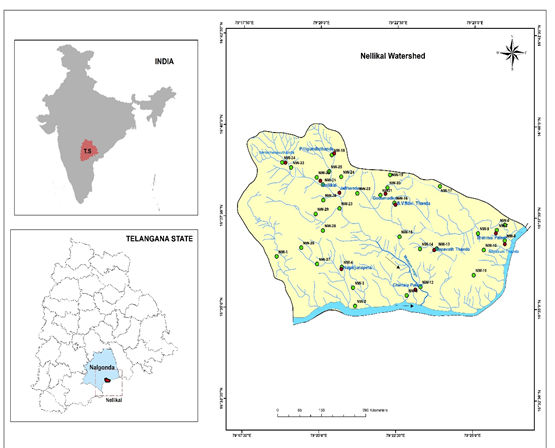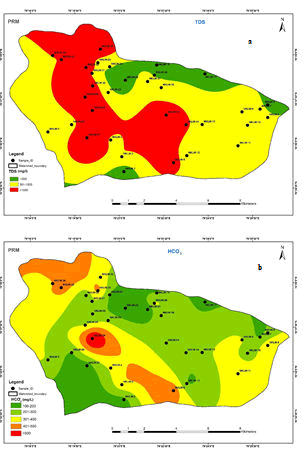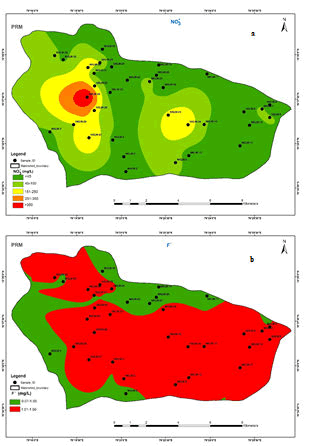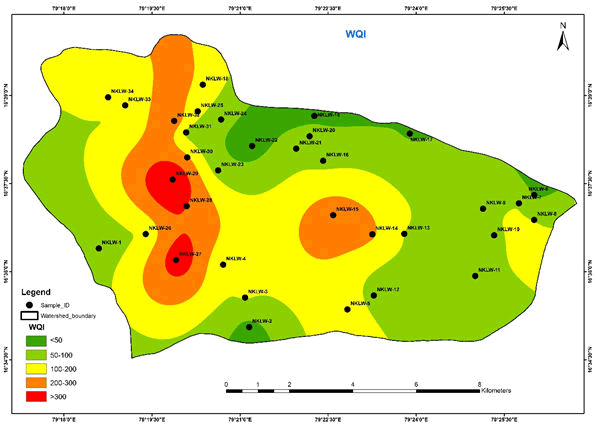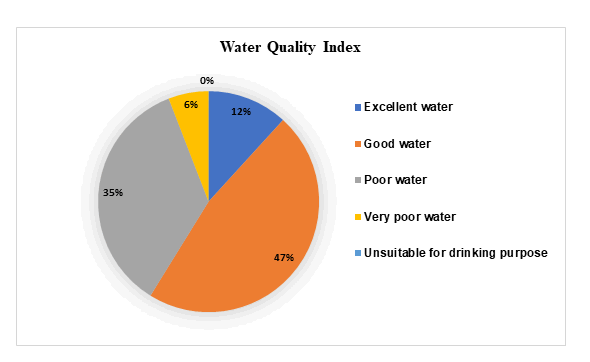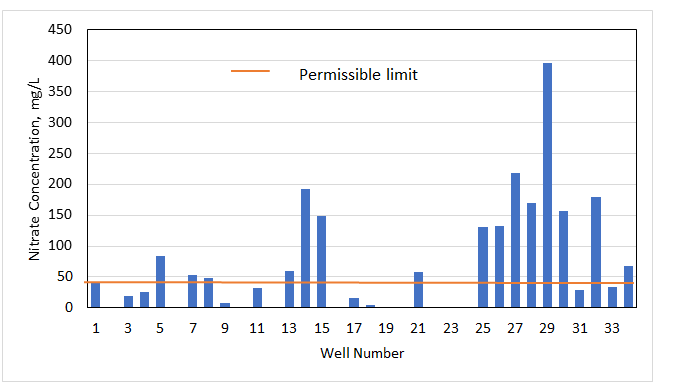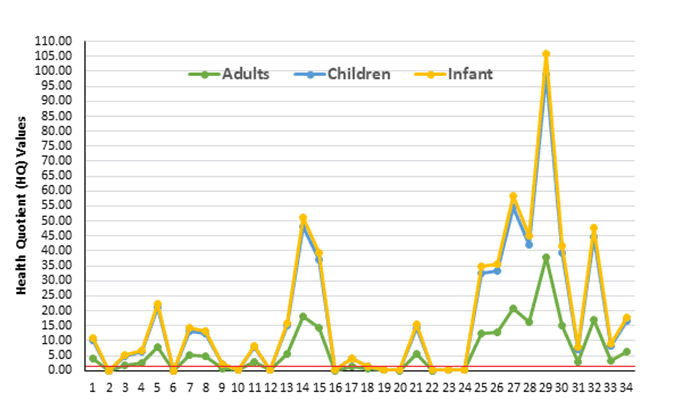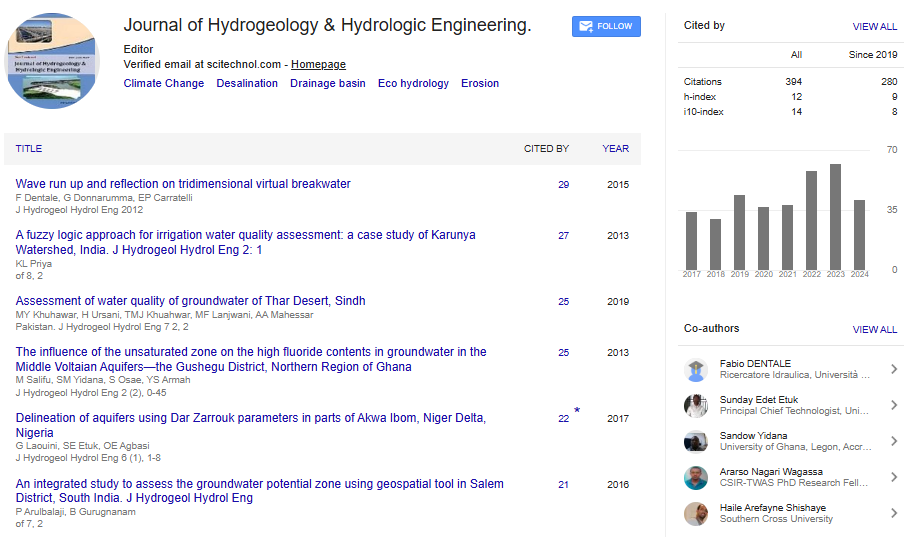Research Article, J Hydrogeol Hydrol Eng Vol: 11 Issue: 5
Groundwater Quality Appraisal through Water Quality Index and Non-Carcinogenic Health Risk Assessment from Nellikal Watershed of Nalgonda District Telangana India
Hari Ramavath* and Panduranga Reddy Inavole
Department of Geology, Osmania University, Hyderabad, Telangana, India
*Correspondence to: Hari Ramavath, Department of Geology, Osmania University, Hyderabad, Telangana, India, Tel: 9705624227; E-mail: ramavath.hari@gmail.com
Received: 26 January, 2022, JHHE-22-52515;
Editor assigned: 31 January, 2022, Pre QC No. JHHE-22-52515 (PQ);
Reviewed: 14 February, 2022, QC No. JHHE-22-52515;
Revised: 28 March, 2022, Manuscript No. JHHE-22-52515 (R);
Published: 04 April, 2022, DOI:10.4172/2325-9647.11.4.221
Citation: Ramavath H, Inavole PR (2022) Groundwater Quality Appraisal through Water Quality Index and Non-Carcinogenic Health Risk Assessment from Nellikal Watershed of Nalgonda District Telangana India. J Hydrogeol Hydrol Eng 11:5.
Abstract
This study described the assessment of groundwater quality using a Water Quality Index (WQI) and non-carcinogenic health risk due to Nitrate in groundwater from rural habitats of Nellikal watershed of Nalgonda district. Groundwater samples are collected and measured for pH, EC, TDS, TH, and major anions and cations. Results revealed that TDS, HCO3- and NO3 concentrations are beyond the WHO permissible limits among the various parameters determined. The groundwater of the study area falls in poor water quality accounts for 35% of samples, and 5.9% of samples are in the very poor category, according to W.Q.I. The risk assessment demonstrated that Hazardous Quotient (HQ) values are in the range of 0.01-105.70; 0.01-99.10; 0.01-37.75 concerning infants, children and adults, respectively. These data demonstrated that most of the samples (71%) showed HQ>1 together for infants and children suggests a severe health effect on infants and children due to groundwater ingestion from the Nellikal watershed. This investigation recommended that water has to treat before supply for drinking in the study region.
Keywords: Groundwater quality; WHO permissible limits; WQI; Health risk assessment; Nellikal Watershed; Nalgonda; Telangana
Introduction
Groundwater is an essential natural resource and currently facing severe pollution, it needs its quality assessment for drinking purposes. Poor groundwater quality has an impact on human health and the environment, and hence sustainable management of groundwater resources requires great concern [1]. In semi-arid and arid regions, factors such as uneven precipitation, large evapotranspiration, soil erosion, and frequent human activities have become inconsistent between supply and demand of water resources is exceptionally prominent [2]. The characteristics of groundwater chemical evolution are the concentrated reflection of environmental change is of great concern for groundwater resource and ecological quality evolution [3,4]. Groundwater quality assumes significance to ascertain its suitability for various purposes, and the concentration of multiple parameters should meet the regulatory limits [5-9]. Therefore, the quality of groundwater should ensure to protect human and soil health, covering water-borne disease and damage to irrigated crops, respectively [8-10].
Understanding of hydro geochemical process is helpful in the assessment of groundwater quality [11,12]. The Water Quality Index (WQI) is capable of complete communication of the water quality data of an area. WQI based maps help understand and raise awareness of groundwater contamination and impose or suggest suitable water treatment for its usage for drinking purposes and management [13]. In addition, groundwater has become an essential source for tribal habitats and solely depending on their needs of drinking purposes. The uniqueness of this investigation is recognizing the potential factors controlling the groundwater chemistry by combining with groundwater quality data and integrating GIS with WQI approach in a virgin area of Nellikal watershed of Nalgonda district Telangana. This study is a first-of-its-kind that has immense value for proper groundwater management for drinking utilities.
The objectives of this investigation are to assess the groundwater quality based on the WHO permissible limits, WQI and Health risk assessment methods for its suitability for drinking purposes, a significant water resource for rural habitats.
Materials and Methods
Study area
The Nellikal watershed located in the Nalgonda district, Telangana The watershed, covering an area of about 120 km2 positioned between latitude 16034’30”N and 16040’30”N to longitude 79018’00”E and 79027’00”E falling in the Survey of India (SOI) topo sheet number 56 P/2 (Figure 1). Mattam vagu flows in Nellikal watershed that further flows into the Krishna River. Nellikal watershed is home to 22,456 inhabitants with an average population density of 189 persons per km2 consisting of 18 villages. It was observed that groundwater levels range between depths of 16 to 30 m bgl [14]. The area is categorized as overexploited due to the large groundwater abstraction for the irrigation of crops, mainly paddy and cotton.
Sampling and analysis
Thirty-four (34) water samples representing groundwater sources were collected randomly to cover the selected study region. These samples were analyzed for physicochemical parameters, major cations, and anions. Water samples are collected in polypropylene bottles following APHA standard methods [15]. PH, EC, and TDS were measured immediately after collecting the samples in the field site. Bicarbonate (HCO3-) and Total Hardness (TH) concentrations were determined by the titrimetric method, whereas the Ion chromatography (882 Compact IC plus, Metrohm) method was used for the determination of major ionic concentration in groundwater.
Water quality index
Evaluation of groundwater quality through the Water Quality Index (WQI) is a widely used tool that summarizes several water quality parameters into a single proper numerical value [16-18]. It is based on the rank and weight given to the measured parameters. Comprehensive assessment of the groundwater suitability for drinking purposes is carried out using the water quality parameters such as pH, EC, TDS, Ca2+, K+, Mg2+, Na+, F-, Cl-, NO3-, SO42-, HCO3- and TH and given weight value according to the significance at the study area under evaluation. WQI calculated as below
Relative weight has been calculated as shown in the following equation.

Where, Wi=Relative weight
wi=Parameters weight
n=Number of parameters
Then quality rating has computed as per the following equation

Where qi=quality rating
Ci=measure concentration for each parameter (mg/L)
Si=standard limit for each parameter according to WHO (mg/L)
Later, sub-indices are calculated by multiplying values obtained in equation (1) and (2)

Finally, calculated SI values for every parameter used to calculate WQI by summing all SI values for a particular sample which gives the quality classification according to their range and water types.

Potential health risk assessment
Potential health risk assessment is a significant index used in defining water quality whether it is fit for drinking purposes. It is essential to know how many chemical concentrations are present in drinking water and their long-term health effects due to its consumption. Understanding the harmful health effects due to contaminants via groundwater ingestion is assigned by health risk assessment. Potential health risk assessment calculation helps evaluate health impact on different age groups [19-20]. The most common health diseases caused by Nitrate are methemoglobinemia/blue baby syndrome, stomach and esophageal cancer and thyroid hypertrophy. Further, it has been reported that groundwater in granitoid terrain of south India contains high Nitrate, which affects more on child and women health compared to adult men due to consumption of untreated water with high nitrate concentration above permissible value. In this study, a health risk assessment due to nitrate consumption which is present as a dissolved ion in groundwater was carried out. Health risk assessment has been calculated from the established formulae (equation (5) and (6)) by measuring daily limit dose (CDI) and Hazard Quotient (HQ), rate the possibilities of non-carcinogenic impact (USEPA, 2004). The daily intake amount of nitrate present in groundwater can be calculated from the following equations:

Here, CDI=daily limit dose (mg/kg/day), C=conc. of nitrate in groundwater (mg/L), DI=Ingestion rate (adults, children, infants; 2, 1.5, 0.8 L/day), F=Exposure frequency (adults, children, infants; 365 days) ED=Exposure Duration (adults, children, infants; 40, 10, 1 years), BW=Average Body Weight (adults, children, infants; 70, 20, 10 kg), AT=Average Time for non-carcinogenic effect (adults, children, infants; 14600, 3650, 365 days)

i.e., Rfd=specific dose reference of a contaminant,
According to the Integrated Risk Information System (IRIS) of USEPA (2012), the permissible dose limit of Nitrate is 1.6 mg/kg/day. If the final value of HQ<1, then there is no impact on human health, but if HQ>1, there is a non-carcinogenic impact on human health, according to USEPA (2012).
Results and Discussion
The summary of groundwater analytical data of the Nellikal watershed presented in Table 1 and their comparison with WHO guideline values for drinking utility.
Groundwater quality based on WHO permissible limits
PH of the groundwater samples is within the allowable limit of WHO 2017 [21-23] guideline values. However, EC is above permissible limits in 23.5% of samples (Table 1). Besides, most of the groundwater samples (91%) are within permissible limits of <1000 mg/L TDS, and 8.82% of samples are fall in slightly saline. Around 91.1% of samples are with high HCO3 content beyond the permissible limit of 150 mg/L. The spatial distribution of TDS and HCO3 concentrations in groundwater samples of Nellikal watershed is shown in Figures 2(a) and 2(b).
| Parameters | Units | Min | Max | Ave | Median | SD | WHO 2017 desire limit mg/L | Samples exceeding permissible limit WHO (2017) mg/L | |
|---|---|---|---|---|---|---|---|---|---|
| No. of samples | % of Samples | ||||||||
| Physicochemical | |||||||||
| pH | ---- | 6.4 | 7.6 | 7.26 | 7.28 | 0.25 | 6.5-8.5 | NIL | NIL |
| EC | µS/cm | 530 | 2290 | 1208.82 | 1070 | 471.35 | 750-1500 | 8 | 23.5 |
| TDS | mg/L | 270 | 1150 | 610 | 545 | 235.77 | 500-1000 | 3 | 8.8 |
| TH | mg/L | 9.9 | 422.75 | 205.59 | 195.94 | 90.26 | 300-500 | Nil | Nil |
| Alk | mg/L | 11.61 | 552.5 | 278.12 | 266.5 | 116.05 | --- | Nil | Nil |
| Anions | |||||||||
| F- | mg/L | 0.07 | 1.19 | 0.56 | 0.53 | 0.32 | 0.6-1.5 | Nil | Nil |
| Cl- | mg/L | 18.64 | 254.9 | 89.8 | 72.94 | 60.71 | 250-600 | Nil | Nil |
| NO3- | mg/L | 0.04 | 396.39 | 67.93 | 32.44 | 88.17 | 45 | 15 | 44.1 |
| SO42- | mg/L | 17.26 | 231.53 | 66.76 | 55.6 | 45.76 | 250-400 | Nil | Nil |
| HCO3- | mg/L | 109.8 | 500.2 | 242.56 | 231.8 | 93.18 | 150 | 31 | 91.1 |
| Cations | |||||||||
| Na+ | mg/L | 16.19 | 238.84 | 76.27 | 67.39 | 43.34 | 50-200 | 1 | 2.9 |
| K+ | mg/L | 0.67 | 195.89 | 16.7 | 2.77 | 43.03 | 12 | 4 | 11.8 |
| Ca2+ | mg/L | 9.9 | 69.27 | 37.93 | 34.25 | 16.77 | 75-200 | Nil | Nil |
| Mg2+ | mg/L | 9.94 | 67.53 | 28.1 | 24.84 | 15.98 | 50-150 | Nil | Nil |
Table 1: Statistical summary of physicochemical parameters, major ions compared with WHO (2017) permissible limits.
Among the various anions and cations measured for groundwater samples collected from the study area and their data are shown in Table 2. The nitrate concentration is the most abundant ion next to bicarbonate, and around 44% of the samples are exceeded the WHO permissible limit for drinking (Figure 3(a)). A high nitrate concentration might be due to agriculture fertilizer runoff/leaching as the study region dominates agricultural activities. The spatial variation of nitrate concentrations in groundwater is presented in Figure 3. All other ions are within the permissible limit for drinking purposes. Though fluoride ions in groundwater were found below the permissible limit of WHO 2017 guideline value of 1.5 mg/L; however, when the concentration range compared with BIS (2012) permissible limit of 1.0 mg/L, and 11.8% of the samples are beyond the permissible limit as shown in (Figure 3(b)). As the study region falls under the fluoride endemic zone district (i.e., Nalgonda), it is also compared with BIS to be cautious about human health [24].
Water quality assessment using WQI values
Groundwater quality and its suitability for drinking purposes based on Water Quality Index (WQI) spatial variations shown in Figure 4. WQI observed range from 40 to 394. The distribution of WQI in the study area is represented as shown in Figure 4. This data reveals that 35% of samples are falling in the poor category, 6% of samples belong to very poor water type, and none of the samples are unsuitable for drinking (Figure 5). This further indicates the study area together 41% of the samples are not acceptable for drinking, which needs to be treated prior to supply for drinking purposes.
Non-carcinogenic risk assessment of nitrate
Water quality plays a critical role and deciding factor in human health and wellbeing around the world. The hydro geochemical studies on groundwater from the Nellikal watershed reveal that elevated concentrations of Nitrate in groundwater are observed. About 44% of the samples in pre-monsoon and 59% of samples in post-monsoon are identified as nitrate concentrations beyond the WHO 2017 permissible limit (i.e. 45 mg/L) for drinking purposes (Figure 6). Based on these observations, the health risk assessment of Nitrate in groundwater in the Nellikal watershed is evaluated to safeguard the health of people living in the study region.
Appraisal of groundwater quality with a focus on Nitrate is a public health concern as the Nellikal watershed belongs to an intensive agricultural region. On the other hand, India is a fundamentally agricultural-based country with irrigation practices that depend on water from river and groundwater resources. Rural habitats depend on groundwater for their livelihood. Further, utilization of groundwater in the agricultural sector also increases due to the scarcity of rains in many regions. In a recent study, it has been reported that nitrate pollution is at risk due to the ingestion of groundwater.
In the present study, the hazard quotient values evaluated from the water quality data are categorized as infants, children and adults. The HQ values found in the range of 0.01-105.70; 0.01-99.10; 0.01-37.75 with respect to infant’s children and adults respectively (Figure 7). Around 71% of groundwater samples shown HQ>1 together for infants and children, besides 65% for adults. Since the elevated concentration found in the study area, there is a profound health effect on infants and children due to groundwater ingestion from Nellikal watershed.
Conclusion
This study summarizes that parameters such as TDS, bicarbonate, and nitrate are above permissible limits of WHO guideline values for drinking. High levels of nitrate were found in 44% of the samples, which is unfit for drinking purposes. The enriched nitrate concentration in groundwater might be due to agricultural practices in the region. The groundwater of the study area falls in poor water quality accounts for 35% of samples, and 5.9% of samples are with very poor category as per WQI. Around 71% of groundwater samples showed hazard quotient (HQ) value is >1 together for infants and children, besides 65% for adults are at risk if consumed the water for drinking. Thus, it is suggested treatment of water is essential before supply for drinking use to protect human health.
References
- Pant R, Zhang F, Rehman F, Rehman FU, Wang G, et al. (2018) Spatiotemporal variations of hydro geochemistry and its controlling factors in the Gandaki River Basin, Central Himalaya Nepal. Sci Total Environ 622:770-782.
[Crossref] [Google Scholar] [Indexed]
- Zhang T, Cai W, Li Y, Geng T, Zhang Z, et al. (2018) Ion chemistry of groundwater and the possible controls within Lhasa River Basin, SW Tibetan Plateau. Arab J Geosci 11:510.
[Crossref] [Google Scholar] [Indexed]
- Yetis R, Atasoy A, Demir YetiÅ? A, YeÅ?ilnacar M (2019) Hydro geochemical characteristics and quality assessment of groundwater in Balikligol Basin, Sanliurfa, Turkey. Environ Earth Sci 78.
[Crossref] [Google Scholar] [Indexed]
- Wang W, Chen Y, Wang W, Xia Z, Li X, et al. (2021) Hydrochemical characteristics and evolution of groundwater in the dried-up river oasis of the Tarim Basin, Central Asia. Journal of Arid Land.
[Crossref] [Google Scholar] [Indexed]
- Subramani T, Rajmohan N, Elango L (2009) Groundwater geochemistry and identification of hydrogeochemical processes in a hard rock region, Southern India. Environ Monit Assess 162:123-137.
[Crossref] [Google Scholar] [Indexed]
- Khatri N, Tyagi S, Rawtani D, Tharmavaram M, Kamboj R (2020) Analysis and assessment of ground water quality in Satlasana Taluka, Mehsana district, Gujarat, India through application of water quality indices. Groundw Sustain Dev 10:100321.
[Crossref] [Google Scholar] [Indexed]
- Reddy BM, Sunitha V, Reddy MPY, Reddy M (2019) Evaluation of groundwater suitability for domestic and agricultural utility in semi-arid region of Anantapur, Andhra Pradesh State, South India. Groundw Sustain Dev 9:100262.
[Crossref] [Google Scholar] [Indexed]
- Sarkar AA, Hassan AA (2006) Water quality assessment of a groundwater basin in Bangladesh for irrigation use. Pak J Biol Sci 9:1677-1684.
[Crossref] [Google Scholar] [Indexed]
- Little J, Kalischuk A, Gross D, Sheedy C (2010) Assessment of water quality in Albertaâ??s Irrigation Districts. (2nd edition), Alberta Agriculture and Rural Development, Alberta. Canada.
- Chaudhary V, Satheeshkumar S (2018) Assessment of groundwater quality for drinking and irrigation purposes in arid areas of Rajasthan, India. Appl Water Sci 8:218.
[Crossref] [Google Scholar] [Indexed]
- Kurakalva R, Kuna G, Vaiphei S, Guddeti S (2021) Evaluation of hydro geochemical profile, potential health risk and groundwater quality in rapidly growing urban region of Hyderabad, South India. Environ Earth Sci 80:383.
[Crossref] [Google Scholar] [Indexed]
- Vaiphei SP, Kurakalva RM (2021) Hydro chemical characteristics and nitrate health risk assessment of groundwater through seasonal variations from an intensive agricultural region of upper Krishna River basin, Telangana, India. Ecotoxicol Environ Saf 213:112073.
[Crossref] [Google Scholar] [Indexed]
- Abbasi T, Tareen J (2012) Water quality indices. Place of publication not identified, Elsevier, Netherlands.
- APHA (2017) Standard methods for the examination of water and wastewater. (23rd edition), APHA method 4110, American Public Health Association, Washington.
- Kadam A, Wagh V, Patil S, Umrikar B, Sankhua R, et al. (2021) Seasonal variation in groundwater quality and benefical use for drinking, irrigation, and industrial purposes from Deccan Basaltic Region,Western India. Environ Sci Pollut Res 28:26082-26104.
[Crossref] [Google Scholar] [Indexed]
- Rawat KS, Singh SK (2018) Water quality indices and GIS based evaluation of a decadal groundwater quality. Landsc Ecol 2:240-255.
[Crossref] [Google Scholar] [Indexed]
- Vaiphei SP, Kurakalva RM, Sahadevan K (2020) Water quality index and GIS-based technique for assessment of groundwater quality in Wanaparthy watershed, Telangana, India. Environ Sci Pollut Res 27:45041-45062.
[Crossref] [Google Scholar] [Indexed]
- Chen J, Wu H, Qian H (2016) Groundwater nitrate contamination and associated health risk for the rural communities in an agricultural area of Ningxia, northwest China. Expo Health 8:349-359.
[Crossref] [Google Scholar] [Indexed]
- Nadia EH, Kenneth PC, Nuria M, Debra TS, Adonina T, et al. (2015) Nitrate in drinking water and bladder cancer risk in Spain. Environ Res 137:299-307.
[Crossref] [Google Scholar] [Indexed]
- Su X, Wang H, Zhang Y (2013) Health risk assessment of nitrate contamination in groundwater: A case study of an agricultural area in Northeast China. Water Resour Manag 27:3025-3034.
[Crossref] [Google Scholar] [Indexed]
- Freeze RA, Cherry JA (1979) Groundwater. Englewood Cliffs, NJ: Prentice-Hall. 1979.
- World Health Organization (WHO) (2017) Guidelines for Drinking-water Quality. (4th edition), WHO, Geneva.
- Ahamed AJ, Loganathan K, Jayakumar R (2015) Hydrochemical characteristics and quality assessment of groundwater in Amaravathi river basin of Karur district, Tamil Nadu, South India. Sustain. Water Resour Manag 1:273-291.
[Crossref] [Google Scholar] [Indexed]
- Bureau of Indian Standards (BIS) IS 10500: 2012 Drinking Water-Specification (second revision) (BIS, New Delhi, 2012).
 Spanish
Spanish  Chinese
Chinese  Russian
Russian  German
German  French
French  Japanese
Japanese  Portuguese
Portuguese  Hindi
Hindi 